Contents
One of the ways to propagate conifers is to harvest and germinate cuttings, as a result of which the varietal characteristics of the tree are preserved. Fir propagates by cuttings without problems, if a number of conditions are provided for the seedlings in the process of growing.
Is it possible to grow fir from a branch
Cuttings are one of the propagation methods used for conifers. It is chosen when it is necessary to preserve the decorative properties of the tree. When grown from seeds, a tree may lose some of its external qualities.
Growing a fir from a cutting is a completely solvable task. It is important to choose a healthy parent tree and cut the shoots at the right time. Even if all conditions are met, only 30-40% of the cuttings take root.
Advantages of propagating fir by cuttings:
- all signs of the mother plant are preserved;
- no special knowledge or skills are required;
- high hardiness of seedlings.
Despite the advantages of the method, cuttings are used less frequently for fir than for cypress, arborvitae and other conifers. If it is not possible to obtain cuttings, then other methods of propagation are chosen: by seeds or grafting.
Features of growing fir from cuttings at home
To root a fir from a branch, consider the following features of this process:
- correctly choose the original tree and its shoots;
- comply with the deadlines for the work;
- prepare the substrate;
- provide the necessary microclimate in the room;
- taking care of established plants.
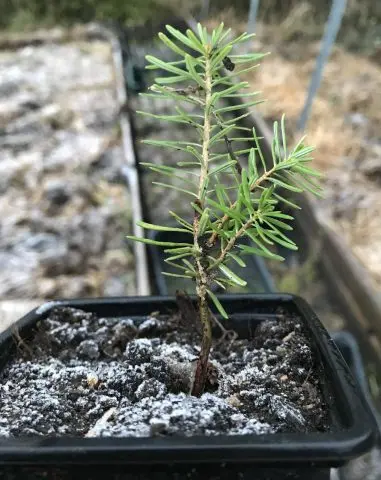
Without processing, cuttings of Siberian, Korean, subalpine, myra fir do not take root. One-color, graceful, European species take root best of all. Even after processing, cuttings of subalpine and Arizona varieties do not give roots.
Terms of cuttings of fir
To grow fir by cuttings, it is important to choose the right time for work:
- at the onset of spring;
- at the beginning of summer;
- at the end of summer;
- in the fall.
The most successful period is the end of winter or spring, when the trees are just beginning to sap flow. In the southern regions it is March, in colder climates it is April. The resulting cuttings are rooted without problems within a year. For work, choose the morning period or a cloudy day.
It is allowed to transfer cuttings to June, when the intensive development of the tree occurs. Such planting material in the current season gives only callus. The root system of culture develops for the next year.
If the first two stages of cuttings are missed, then the shoots are cut in August. During this period, their growth stops and desalination occurs. In September-November, winter cuttings are prepared.
Material collected in spring and summer can be planted immediately. When collecting cuttings for propagation of fir in the fall, they are kept until spring in a cool room. At the same time, they provide a temperature regime from +1 to +5 ° С and high humidity. It is best to store the material in a plastic container and refrigerator.
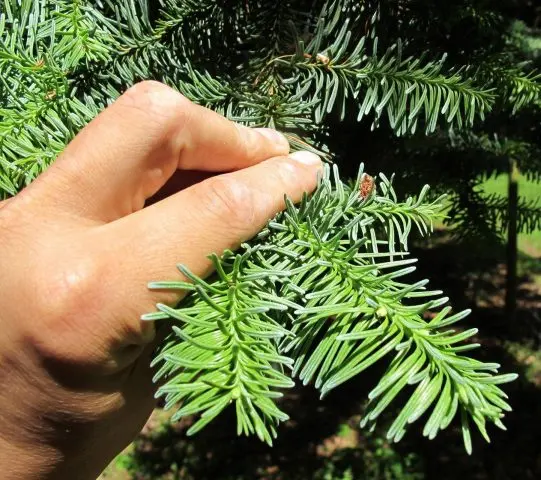
How to grow fir from a twig
The process of propagation of fir branches includes several stages. First, cuttings are selected and harvested, then they are provided with storage conditions. Rooting will require a substrate, containers and a certain microclimate. When the cuttings take root, they are transferred to an open area.
Selection and preparation of cuttings
It is best to use cuttings from young trees aged 4 to 8 years. Look after the branches from the top of the crown. If cuttings are cut from the lower or middle sections, then the likelihood of their rooting will be significantly reduced. In such seedlings, the trunk has a curved shape, and the crown branches incorrectly.
Healthy annual shoots are selected from the parent tree. The optimal length of the cuttings is from 10 to 25 cm. The apical bud should be on the branch. If you damage it, then the trunk will begin to branch, and the crown will take an irregular shape.
To cut the cuttings, use a secateurs or a knife. The cut should be located 1 cm down from the place of desalcation. This area is clearly visible due to the color transition from green to brown.
At a distance of 4 – 6 cm, needles and small branches are completely removed. Under favorable conditions, new roots also appear from these places.
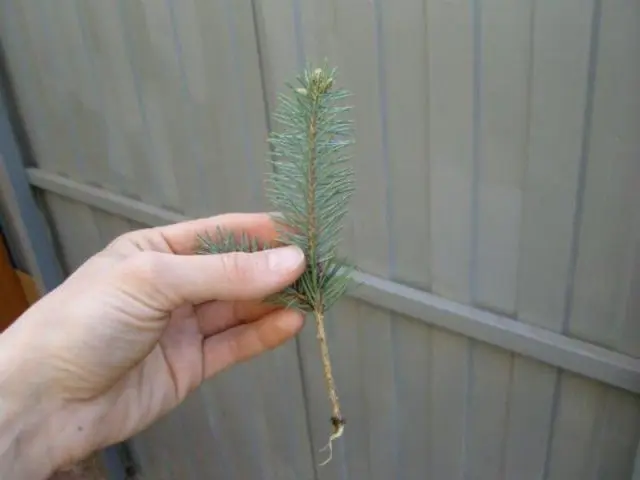
How to root a fir from a branch
After receiving the planting material, they begin to root it. Branches do not hold water. If the shoots are collected at the end of summer or autumn, then they are sprayed with water and wrapped in a damp cloth.
Cuttings ready for planting are placed in a solution of a root growth stimulator. Without such treatment, fir practically does not take root. Use special preparations Kornevin, Root, Ribav. They are dissolved in water according to the instructions.
Good results are obtained by rooting cuttings of fir in a solution of IBA – indolylbutyric acid. It is obtained in a concentration of 0,01%. At an increased content, the acid has a toxic effect. Best of all solution works at a temperature of +20 °C. The working fluid is unstable to light and heat.
Additionally, the lower edge of the cuttings is lowered into a solution of potassium permanganate or the drug Fundazol. This will disinfect the material and avoid fungal diseases.
For cuttings of fir in winter, a substrate is prepared, consisting of soddy land, humus and sand. All components are taken in equal proportions. If soil from the site is used, then it is first heated in an oven for disinfection.
For rooting cuttings, plastic containers are used, in which drainage holes are made to remove moisture. The optimal height of containers is from 10 to 15 cm.
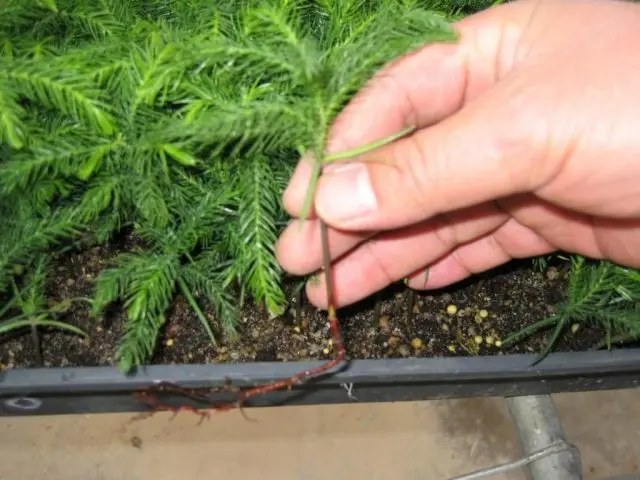
The order of cuttings of fir at home in winter:
- Earth mixed with humus is poured into containers in layers, sand is placed on top.
- The cuttings are deepened by 2 – 6 cm at an angle of 45 °. Leave 10 cm between them.
- Landings are covered with a film.
- The substrate is watered abundantly.
The material is rooted at a temperature of 20 – 25 ° C and a humidity of 90%. Additionally, diffused light is required. If the day is too short, turn on the phytolamps.
The process of root formation takes up to 9 months. First, callus is formed in the lower part of the shoot in the form of neoplasms on cracks and incisions. Then roots grow. The appearance of callus does not guarantee that the seedling will take root.
Video about the reproduction of fir cuttings at home:
How to plant a fir cuttings in open ground
The following year, rooted plants are transferred to open ground. For fir, choose a sunny place or partial shade. Saplings do not tolerate urban pollution. All varieties require moist, well-drained soil.
Cuttings are transplanted on a cloudy or rainy day. The place is prepared for 2 – 3 weeks. After shrinkage of the soil, they begin to transfer the seedling to a new place.
Fir planting order:
- In the selected area, holes are made with a diameter of 40 cm and a depth of 50 cm.
- A layer of crushed stone or expanded clay with a thickness of 10 – 15 cm is placed at the bottom.
- The cuttings are carefully removed from the container, trying not to destroy the earthen ball.
- The plant is transferred to a recess, the roots are covered with earth.
- The soil is watered abundantly.
- Plantings are covered with paper caps or a frame.
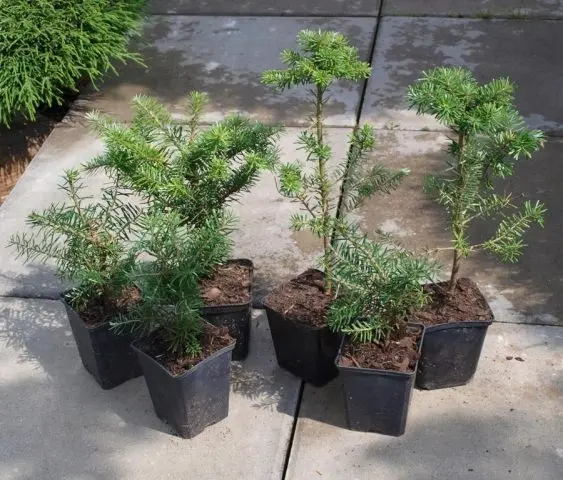
Care after planting fir cuttings
To grow a tree from a fir branch, it is important to properly care for young plants. The first years after planting, their development is slowed down.
Plantings are regularly watered, but do not allow stagnation of moisture in the soil. Periodically loosen the soil to a depth of 25 cm and weed weeds. For top dressing, Kemira fertilizer or other mineral complexes are chosen.
For soil mulching, peat or sawdust is used, which is poured into the trunk circle. For the winter, a young tree is covered with spruce branches or non-woven fabric.
Conclusion
Fir cuttings reproduce without problems if you follow the basic rules. Work begins with the preparation of shoots, which are germinated at home. Seedlings are transferred to a permanent place, where they are provided with regular care.









